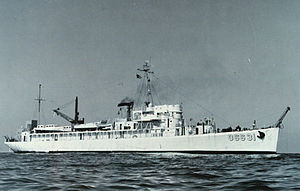 USS Mobjack (AGP-7) off Houghton, Washington, on her commissioning day, 17 September 1943
| |
| History | |
|---|---|
| Name | Mobjack (AVP-27) |
| Namesake | Mobjack Bay, on the western shore of Chesapeake Bay in Virginia |
| Builder | Lake Washington Shipyard, Houghton, Washington |
| Laid down | 25 February 1942 |
| Launched | 2 August 1942 |
| Sponsored by | Mrs. H. R. Peck |
| Reclassified | Motor torpedo boat tender (AGP-7) 11 March 1943 |
| Commissioned | 17 October 1943 |
| Decommissioned | 21 August 1946 |
| Honors and awards | Three battle stars for her World War II service |
| Fate | Transferred to U.S. Department of Commerce 21 August 1946 |
| General characteristics (Seaplane tender) | |
| Class and type | Barnegat-class seaplane tender, converted during construction into a motor torpedo boat tender |
| Displacement |
|
| Length | 310 ft 9 in (94.72 m) |
| Beam | 41 ft 1 in (12.52 m) |
| Draft | 13 ft 6 in (4.11 m) |
| Installed power | 6,000 horsepower (4.48 megawatts) |
| Propulsion | Four diesel engines, two shafts |
| Speed | 18.2 knots |
| Complement | 360 |
| Sensors and processing systems | Radar; sonar |
| Armament |
|
 USC&GS Pioneer (OSS 31) in 1946.
| |
| Name | Pioneer (OSS 31) |
| Namesake | Pioneer, one who goes before, as into the wilderness, preparing the way for others to follow |
| Acquired | 21 August 1946 |
| In service | by April 1947 |
| Out of service | by May 1966 |
| Fate | Sold for scrapping 4 May 1966 |
| General characteristics (Survey ship) | |
| Type | Ocean survey ship |
| Length | 311.6 ft (95.0 m) |
| Beam | 41 ft (12 m) |
| Draft | 13.8 ft (4.2 m) |
USS Mobjack (AVP-27/AGP-7) was a motor torpedo boat tender in commission in the United States Navy from 1943 to 1946. She saw service in the Pacific theater during the latter portion of World War II.
After the conclusion of her Navy career, the ship served in the United States Coast and Geodetic Survey from 1946 to 1966 as the survey ship USC&GS Pioneer (OSS 31), the third Coast and Geodetic Survey ship of the name. Pioneer operated in the Pacific Ocean during her career, making an important discovery of magnetic striping on the ocean floor that made a major contribution to the development of the theory of plate tectonics. She also took part in the International Indian Ocean Expedition, becoming the first ship in the history of the U.S. Coast and Geodetic Survey to visit the Indian Ocean.